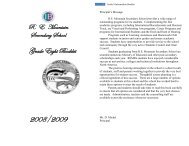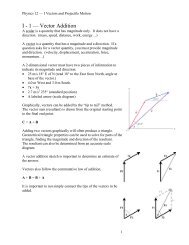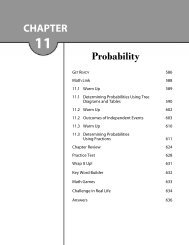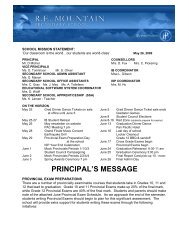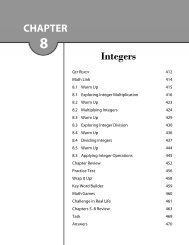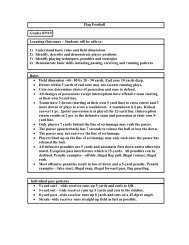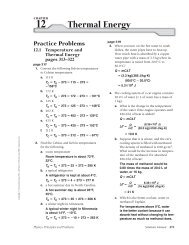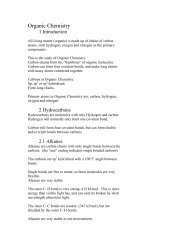Physics Solutions Manual
Physics Solutions Manual
Physics Solutions Manual
Create successful ePaper yourself
Turn your PDF publications into a flip-book with our unique Google optimized e-Paper software.
Chapter 24 continued<br />
F Bqv<br />
(4.010 2 T)(3)(1.6010 19 C)<br />
(9.010 6 m/s)<br />
1.710 13 N<br />
25. Doubly ionized helium atoms (alpha particles)<br />
are traveling at right angles to a magnetic<br />
field at a speed of 4.010 4 m/s. The<br />
field strength is 5.010 2 T. What force<br />
acts on each particle?<br />
F Bqv<br />
(5.010 2 T)(2)(1.6010 19 C)<br />
(4.010 4 m/s)<br />
6.410 16 N<br />
Section Review<br />
24.2 Forces Caused by<br />
Magnetic Fields<br />
pages 652–659<br />
page 659<br />
26. Magnetic Forces Imagine that a currentcarrying<br />
wire is perpendicular to Earth’s<br />
magnetic field and runs east-west. If the current<br />
is east, in which direction is the force<br />
on the wire?<br />
up, away from the surface of Earth<br />
27. Deflection A beam of electrons in a<br />
cathode-ray tube approaches the deflecting<br />
magnets. The north pole is at the top of the<br />
tube; the south pole is on the bottom. If you<br />
are looking at the tube from the direction of<br />
the phosphor screen, in which direction are<br />
the electrons deflected?<br />
to the left side of the screen<br />
28. Galvanometers Compare the diagram of a<br />
galvanometer in Figure 24-18 on page 655<br />
with the electric motor in Figure 24-20 on<br />
page 656. How is the galvanometer similar<br />
to an electric motor? How are they different?<br />
Both the galvanometer and the electric<br />
motor use a loop of wire positioned<br />
between the poles of a permanent magnet.<br />
When a current passes through the<br />
loop, the magnetic field of the permanent<br />
magnet exerts a force on the loop.<br />
The loop in a galvanometer cannot<br />
rotate more than 180°. The loop in an<br />
electric motor rotates through many<br />
360° turns. The motor’s split-ring commutator<br />
allows the current in the loop to<br />
reverse as the loop becomes vertical in<br />
the magnetic field, enabling the loop to<br />
spin in the magnetic field. The galvanometer<br />
measures unknown currents;<br />
the electric motor has many uses.<br />
29. Motors When the plane of the coil in a<br />
motor is perpendicular to the magnetic<br />
field, the forces do not exert a torque on the<br />
coil. Does this mean that the coil does not<br />
rotate? Explain.<br />
Not necessarily; if the coil is already in<br />
rotation, then rotational inertia will carry<br />
it past the point of zero torque. It is the<br />
coil’s acceleration that is zero, not the<br />
velocity.<br />
30. Resistance A galvanometer requires 180 A<br />
for full-scale deflection. What is the total<br />
resistance of the meter and the multiplier<br />
resistor for a 5.0-V full-scale deflection?<br />
V 50 V<br />
R 28 k<br />
I 180 A<br />
31. Critical Thinking How do you know that<br />
the forces on parallel current-carrying wires<br />
are a result of magnetic attraction between<br />
wires, and not a result of electrostatics?<br />
Hint: Consider what the charges are like when<br />
the force is attractive. Then consider what the<br />
forces are when three wires carry currents in the<br />
same direction.<br />
If the currents are in the same direction,<br />
the force is attractive. If it were due to<br />
electrostatic forces, the like charges<br />
would make the force repulsive. Three<br />
wires would all attract each other, which<br />
could never happen if the forces were<br />
due to electrostatic charges.<br />
488 <strong>Solutions</strong> <strong>Manual</strong> <strong>Physics</strong>: Principles and Problems<br />
Copyright © Glencoe/McGraw-Hill, a division of The McGraw-Hill Companies, Inc.





